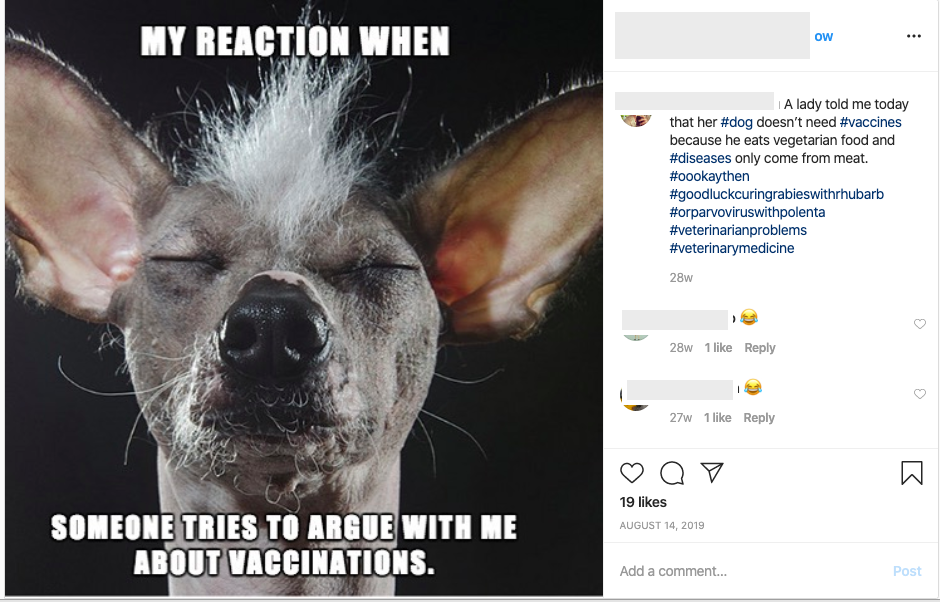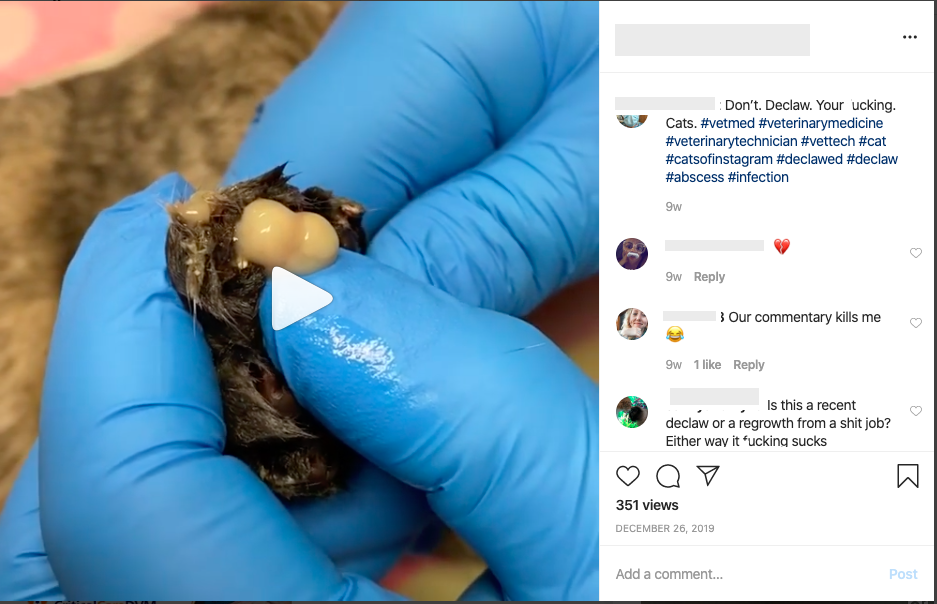By Danielle Lambert
As a former veterinary practice manager, I read a lot of other managers’ posts on forums. When managers do post about social media, I notice a common trend.
If a veterinary practice manager is asking something about social media, it’s often because they’re having an issue with an employee. A veterinarian is sharing photos of patients on her personal Facebook without permission. There’s a situation where 2 vet techs keep fighting with each other publicly on Twitter. Your vet assistant keeps posting surgery videos to Instagram. veterinary team social media bad posts
Practice managers always want to know how they can control this awful social media behavior. I don’t blame them. The way some veterinary “professionals” portray themselves online scares me more than tornados, The Ring and finding parking in Boston combined. It can be B-A-D.
My response to them, however, is a little unexpected: Don’t blame social media for bad hiring and training.
[RELATED: 4 Tips for Veterinary Team Social Media Policies]
Just like a well-trained and highly-educated team can function in the hospital without a manager micro-managing them all day, they can function professionally online without higher-ups stalking and obsessing over them. If your team is misbehaving online, bad hiring & training are to blame.
Bad behavior is bad behavior, online or on the town
It is a bold statement to say that social media isn’t the root cause of bad behavior online. Not only that, hiring and training are a big part of our jobs as veterinary practice managers. I don’t mean to insult that work-intensive process. I’ve made those training checklists, and I’ve checked them twice. So let me explain!
Let’s use this example: A drunk employee is sitting at a local bar yelling about how they hate your practice. That isn’t the bar’s problem, it’s a problem between you and the employee.
Maybe this employee is angry that you gave them a new task that they don’t understand. Perhaps they don’t respect your veterinarians because they don’t see eye-to-eye on a medical protocol. (Or maybe they’re suffering from a level of compassion fatigue that only a bottle of Jameson understands).
Worst case scenario, this employee is simply NOT a responsible and respectable human. (Sometimes a bad egg is a bad egg!) No matter how you look at it, it’s a hiring and training issue. That same rule applies for bad behavior on social media.
[RELATED: 5 Must-Have Social Media Tools for Your Veterinary Hospital]
Don’t be naive, and don’t be a pushover
Veterinary practice managers often think that having a social media policy is enough to manage their employees’ social media behavior. (By the way, you totally should have a social media policy).
If just having a social media policy somewhere in your handbook could completely control veterinary teams, then looking through the #VetLife or #VetTech hashtags on Instagram wouldn’t horrify me. (Spoiler alert: A lot of people identifying themselves as veterinary professionals aren’t acting very professional. Bonus for practice owners: They’re usually publicly identifying exactly where they work).

Whether you like it or not, your veterinary team is LIKELY going to post things about patients on their social media, UNLESS they fully understand why they shouldn’t. I’m not naive enough to assume my team never breaks the rules and posts pictures or stories from the clinic. However, the reality is that – because their profiles are private – I can’t always see it.
Since our social media policy is understood, staff members alert me when inappropriate social media posts happen. I don’t take these reports lightly, and I always address them.
I have had to discipline staff members for social media behavior. However, I didn’t blame social media for this problem. I blamed hiring and training. I don’t write off social media, I look at what I need to do better as a manager to avoid these problems in the future.
[RELATED: 4 Tips for Veterinary Team Social Media Policies]
Now that I have an awesome team in place at my practice, I worry less about social media issues. Having a well-trained, well-educated team at your veterinary practice is the best way to ensure they act responsibly on social media. A good team also REALLY helps with organically building a great online reputation, but that’s another topic all-together.
Identify the real issue
When you can’t blame social media, what do you blame? Here are a few examples.
If staff members are lashing out against each other in Facebook comments, you have a company culture and team issue. Sit the team members down, and deal with them appropriately.
If a veterinary receptionist tweets that one of your clients is THE WORST PERSON AND SHE HOPES HER CAT DIES… Ouch. You’ve hired a sociopath. Alternatively, maybe this is a situation where the manager needs to fire the client, not just the employee. Find out which it is, and do what needs to be done.
If a team member is posting things online that bash your client’s decisions, ie: “This is why breeders suck!” or “People who de-claw their cats are evil!”, you hired the wrong person. This common problem is a big one that I want to emphasize. I see it a lot on Instagram under the #vettech and #veterinary hashtags! If someone that works for you doesn’t agree with services you offer to clients, they probably shouldn’t work for you. (Because, um, integrity).
I saw this post on Instagram, which even includes an identifiable image of the patient. My brain exploded for this person’s practice manager.

Being on the same page is so critical to a veterinary team. Sure, there are certain things – like declaws – that no one LOVES doing. We’re not here to debate the ethics of declawing.
However, identifying a patient that was declawed at your practice, and making negative comments is not doing anyone any good. Imagine how angry that pet owner that just paid you to declaw their cat is going to feel when they see that post. That veterinary staff member’s Instagram post just lost you a client!
I highly recommend the #Pyometra hashtag on Instagram if you want to see a lot of other posts that will lose you a client or two.
Hire for values, and train for expectations
An important point to recognize is this: No social media policy or strategy can replace good hiring, open communication and quality training.
[RELATED: 5 Must-Have Social Media Tools for Your Veterinary Hospital]
Hiring people with the same customer service and WE LOVE PETS LIKE THEIR OUR OWN attitude as you will help you avoid social media headaches down the road.
All of my social media and internet skills can’t fix your online reputation if your staff is subpar.
But even the best employees might miss the mark when it comes to what they should and shouldn’t post on social media. So in the end, make your expectations clear with a social media policy.
[READ NEXT: 4 Tips for Veterinary Team Social Media Policies]

